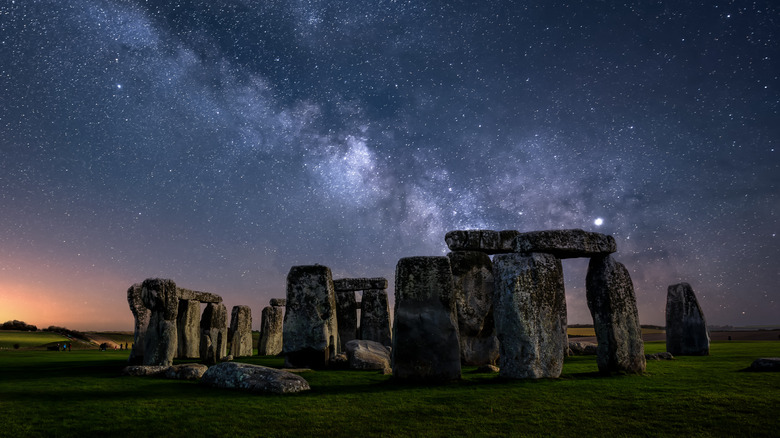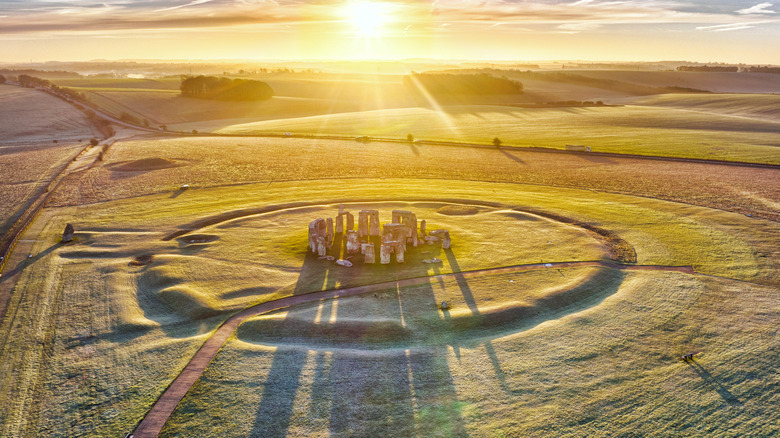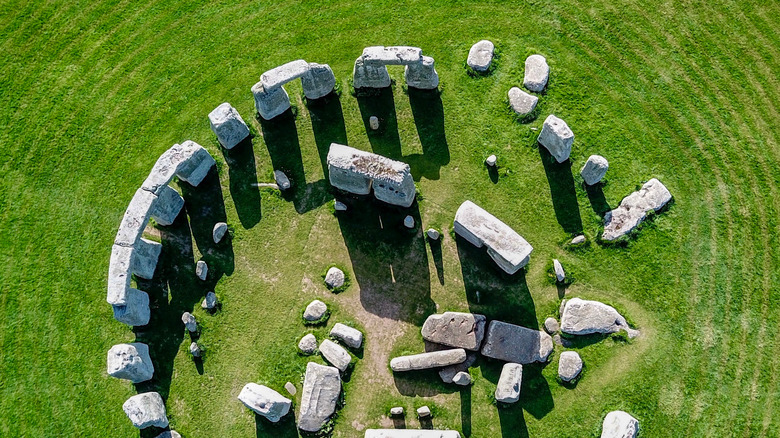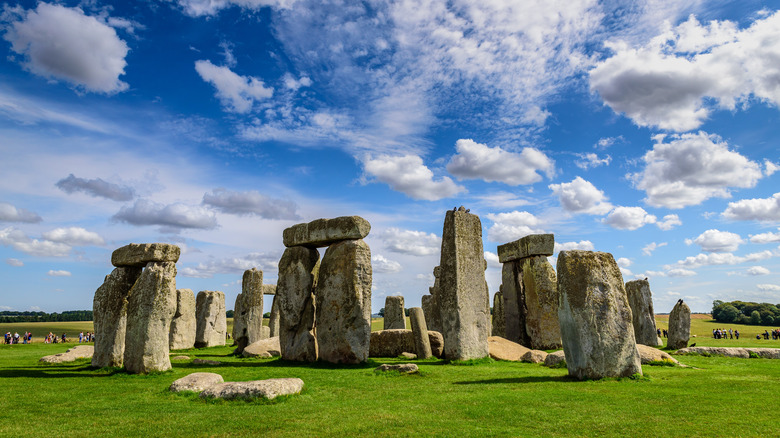This Compelling New Stonehenge Theory Confirms What We Suspected All Along
One of the most famous and intriguing monuments in the world is Stonehenge. Found on Salisbury Plain in southern England, Stonehenge consists of a collection of huge stones arranged in a rough circle, according to History. As a result, it's sometimes called the Stone Circle, according to English Heritage. Stonehenge is considered one of the most famous British landmarks, with almost 1 million visitors a year. It was declared a UNESCO World Heritage Site in 1986. The largest of the stones is estimated to weigh 40 tons and measures 24 feet high. The six remaining lintel stones — those laid across the uprights — are locked into place utilizing techniques often associated with woodworking, including mortise and tenon joints (securing them to the uprights) and tongue and groove joints (securing them to each other). Though the stones appear gray to the modern eye, researchers speculate that they originally appeared much whiter, even brighter, than they do now. It all beggars the imagination.
Some of Stonehenge's appeal can likely be attributed to its mystique. Though the reasons behind Stonehenge's creation remain unknown, many experts have wondered as to its original purpose. Some theories revolve around religion, with people speculating that Stonehenge was used as a healing site, while others think it might have been built to honor ancestors, according to Britannica. But new evidence from researchers suggests that neither of these theories are true. The true origins of Stonehenge might fall in line with a simple theory that many people have wondered about all along (via The Past).
History of Stonehenge
Stonehenge is certainly an ancient site. The monument was first created as much as 5,000 years ago, according to History, though the full installation of the Stonehenge rocks wasn't completed until 1600 B.C. That means construction at Stonehenge went on for a whopping 1,400 years or so. As part of this construction, a lot of labor-intensive work was carried out, including digging a large ditch, cutting and carrying massive stones from miles away, and arranging these stones in place at Stonehenge. With the rocks weighing between 4 and 40 tons and laborers working without the benefit of modern machinery, this transport was clearly no easy feat, though precisely how it was done remains a topic of speculation.
Over the years, many different archaeologists have surveyed the site, including John Aubrey in 1666, according to English Heritage. Aubrey was an antiquarian, or someone who studies antiques. After exploring Stonehenge, he came to believe that the monument was a religious site which had been created by the Druids. More than simply a nature-based religious group, the Druids (per Britannica) were also scholars of a sort, serving as judges and teachers. They were prominent in England from around the 3rd century B.C. until the Romans invaded. But this theory would later be disproved when the stones were dated to many thousands of years before the Druids arrived on the scene.
Odd theories behind the origins of Stonehenge
Since modern people started to study Stonehenge, a persistent question has remained as to its origins and purpose. Though scientists have been able to use scientific techniques like carbon dating to identify details about when the monument was built, the purpose of the monument remains opaque (via History).
Some of the earliest theories about Stonehenge include the myth that it was built by the wizard Merlin, according to National Geographic. According to this theory, the stones were moved to England from Ireland at the command of King Arthur's uncle, King Ambrosium Aurelianus, to create a memorial to honor slain warriors (via Voices From the Dawn).
Equally strange theories have been touted in modern times, including speculation by some extraterrestrial fanatics who believe the monument was built by aliens, according to The New York Times, as "a landing pad for spacecraft." Other interpretations have come straight from the mouths of educated experts, including a theory from a gynecologist who says Stonehenge is meant to represent Mother Earth's vagina and birth canal.
Scientific speculation
Still, for every strange theory, there's a scientifically-backed alternative. For instance, one of the popular theories about Stonehenge is that it was once a cemetery, according to the New Scientist. This theory is supported by scientific evidence which suggests that cremated bodies were buried in the area around Stonehenge about 5,000 years ago, according to The New York Times. Well over 200 bodies are thought to have been buried at the site.
Other experts think that Stonehenge was meant to be a place for the dead in a broader sense, according to the New Scientist. This theory relies on the closeness of a nearby monument, Woodhenge, which dates back to around 4,500 years ago. Experts note that Woodhenge had a similar form to Stonehenge, and speculate that, where Stonehenge was used in ceremonies to represent the dead, Woodhenge may have been used to represent the living, according to NPR. The sites could have been important features of the summer and winter solstice ceremonies.
But one set of theories has often stood above the crowd. These popular and seemingly intuitive theories suggest that Stonehenge may be a massive calendar.
The new research
Stonehenge has several features which have made experts wonder if it is some sort of astronomical calendar, including orientation of stones with the summer and winter solstices, according to The Past. Now, new evidence from a research study out of Bournemouth University in the U.K. gives more weight to the theory.
In the study, features of Stonehenge are explained with relation to the solar calendar, including analysis of how the arrangement of the stones may be designed to line up with the longest and shortest days of the year, according to NBC News. Additionally, the study's authors suggest that the original formation of Stonehenge, which once held 30 massive stones, was designed to reflect the number of days in a month. This would have created a calendar of 360 days, split into 12 separate months. Additional features of Stonehenge were also identified in the study as potentially related to leap years.
If Stonehenge truly was a solar calendar, it would be far from the only one of its kind. Similar solar calendars can be found all over the globe from around the same time period, including Egypt, according to The Past. Still, it would be a novel example within the United Kingdom.
Criticism of the theory
However, the study hasn't gone unchallenged. Some experts have said that the findings remain largely speculative, and point out logical flaws in the argument, according to NBC News. Some such experts have noted that the building of such a time- and labor-intensive clock makes little sense. Others have identified holes in the evidence behind the study, including the lack of any stones indicating the separation of the 12 months, supposedly a key feature of the Stonehenge calendar.
As Stonehenge is constantly being investigated, other studies in recent years have also popped up, providing new evidence and information about the site. One recent analysis revealed that the land Stonehenge is built on was actually an open plain when the site was first created, rather than a forested region, as experts originally believed (via Express). These plains would have been traversed by hunter-gatherers for millennia before Stonehenge was built. Though the complete implications of this new information aren't immediately clear, the continual development of new evidence over time will likely spawn newer and more defined theories about Stonehenge's origins. Who knows? Eventually, someone may discover evidence that determines, once and for all, why exactly Stonehenge was built.





